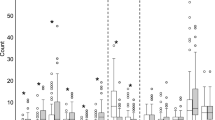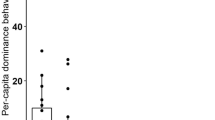Summary
Queens ofMyrmica rubra L. living in natural groups of workers, have been shown to range from sociable to solitary (Brian, 1986b). More data are now presented to show that the sociable queens tend to inhabit the core near the eggs, to be heavier as a result of having a well developed ovary and fat-body, to be at least in their second year of age and to lay more eggs. The solitary queens live peripherally and are lighter, have shorter ovaries that are either undeveloped or degenerate and only lay a few eggs. They are a mixture of first-year queens, spent queens or infirm ones.
Worker populations vary in the degree to which they regulate the dispersion of queens; those which oppose central clustering also reduce fecundity. Thus both the queens by their mutual aversion and the workers by their grading of queens restrict entry into the nest core. Only the mature queens that can lay sex-competent eggs and so contribute to the full development of the society are able to frequent the core.
Resume
On a déjà montré (Brian, 1986b) que la sociabilité des reines deMyrmica rubra L. variait de l'état solitaire à très sociable. On rapporte ici que dans la colonie, les reines sociables se trouvent à proximité des œufs. Ces reines sont, au moins dans leur seconde année, plus lourdes car leurs ovaires et les tissus adipeux sont plus développés et leur fécondité est supérieure à celle des reines solitaires. Les reines solitaires vivent à la périphérie de la colonie et sont plus légères; leurs ovaires sont plus petits soit parce qu'ils se sont moins développés, soit parce qu'ils ont dégénéré. La fécondité est faible. Il s'agit de jeunes reines, de reines très âgées ou parfois de reines blessées.
Les populations d'ouvrières varient en fonction du degré avec lequel elles régulent la répartition des reines; celles qui empêchent leur regroupement diminuent également la fécondité. Ainsi l'aversion mutuelle des reines et la régulation de la caste par les ouvrières limitent le nombre des reines présentes au cœur de la société. Seules les reines en pleine maturité qui peuvent pondre des œufs bipotentiels et ainsi contribuer au développement de la colonie peuvent fréquenter le cœur du nid.
Similar content being viewed by others
References
Brian M.V., 1986a. — Bonding between workers and queens in the ant genusMyrmica.Anim. Behav., 34, 1135–1145.
Brian M.V., 1986b. — The distribution, sociability and fecundity of queens in normal groups of the polygyne antMyrmica rubra L.Insectes Soc., 33, 118–131.
Brian M.V., Hibble J., 1964. — Studies of caste differentiation inMyrmica rubra L. 7. Caste bias, queen age and influence.Insectes Soc., 11, 223–238.
Brian M.V., Rigby, 1978. — The trophic eggs ofMyrmica rubra L.Insectes Soc., 25, 89–110.
Brian M.V., Jones R.M., 1980. — Worker population structure and gyne production in the antMyrmica.Behav. Ecol. Sociobiol., 7, 281–286.
Elmes G.W., 1973. — Observations on the density of queens in natural colonies ofMyrmica rubra L. J. Anim. Ecol., 42, 761–771.
Elmes G.W., 1976. — Some observations on the microgyne form ofMyrmica rubra L.Insectes Soc., 23, 3–22.
Evesham E.J.M., 1984. — Queen distribution movements and interactions in a semi-natural nest of the antMyrmica rubra L.Insectes Soc., 31, 5–19.
Lange R., 1958. — Der Einfluss der Konigin auf die Futterverteilung im Ameisenstaat.Naturwiss., 45, 196.
Passera L., Suzzoni J.P., 1984. — La ponte d'œufs préorientés par la fourmiPheidole pallidula: caractéristiques biologiques des reines à la fin d'hibernation.Insectes Soc., 31, 155–170.
Petersen-Braun M., 1982. — Intraspezifisches Agressionverhalten bei der PharaomeiseMonomorium pharaonis L.Insectes Soc., 29, 25–33.
West-Eberhard M.J., 1978. — Temporary queens inMetapolybia wasps: non-reproductive helpers without altruism?Science, 200, 441–443.
Wilson E.O., 1974. — Aversive behaviour and competition within colonies of the antLeptothorax curvispinosus.Ann. Ent. Soc. Am., 67, 777–780.
Author information
Authors and Affiliations
Rights and permissions
About this article
Cite this article
Brian, M.V. The behaviour and fecundity of queens of different ages in synthetic groups ofMyrmica rubra L. with different worker populations. Ins. Soc 35, 153–166 (1988). https://doi.org/10.1007/BF02223929
Received:
Accepted:
Issue Date:
DOI: https://doi.org/10.1007/BF02223929




